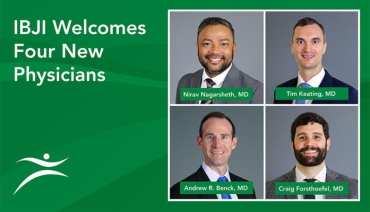Since technologies are constantly changing and improving, IBJI strives to provide patients with the most innovative and safe orthopedic care available. In the last few years, there have been a lot of conversations and studies around the Intracept procedure.
Many have called the Intracept procedure life-changing. Patients have stated that it significantly reduced their pain and improved their mobility. Some patients have returned to the activities they did years before their back pain first started.
And what’s most significant is that some patients have experienced a 100% reduction in back pain following the Intracept procedure.
This blog features a Q& A from our two trained Intracept procedure experts: David Schneider, DO, a physical medicine and rehabilitation physician with fellowship training in sports and spine medicine, and Thomas Gleason, MD, an orthopedic surgeon with fellowship training in adult spine surgery.
They answer common questions about the Intracept procedure, including how it’s done and what former chronic back pain sufferers are saying about it.
How Is the Intracept Procedure Performed?
Dr. Schneider and Dr. Gleason: We put the patient under deep sedation or fully asleep. It is an outpatient procedure that can be done at any hospital. We anesthetize the tissue above the bone.
Using an x-ray in real time, we pass a special needle or trochar through the pedicle, a bone that attaches to the vertebral body, using multiple views on x-ray to make sure it goes directly through. We know that the vertebral basal nerve is in a certain part of the bone. You can actually see this nerve in some people on MRI, so we know exactly where the burn, or ablation, needs to occur.
We put in a second curved tool that gets to the center or trunk of the nerve. Then we insert a “J” probe and ablate the nerve for 15 minutes at 85 degrees Celsius, which is 185 degrees Fahrenheit.
Are There Any Stitches or Hardware Needed for the Intracept Procedure?
Dr. Schneider: It’s a very small incision and no stitches are needed. It can be closed with a steri-strip which is basically a band-aid. With the Intracept procedure, the beautiful thing is that there’s no hardware. You go in and go out and there are no sutures. It’s just amazing that we can fix somebody’s pain and treat the underlying problem without putting screws or cages into a lumbar spine.
How Many Studies Have Been Done on the Intracept Procedure?
Dr. Schneider: There have been five and the last time I checked, there were 2,300 patients who have had the Intracept procedure done. 474 patients have been part of clinical studies.
Dr. Gleason: All five studies were prospective, randomized studies. Two of them had short notice term as well as long-term results thus giving us five papers.
Another study compared them to patients who have had non-surgical management, such as injections, medications, therapy, and things of that nature.
How New Is this Procedure?
Dr. Gleason: It was just recently FDA approved within the last few years. The randomized studies that you rely on strongly have only been out for about a year or two. It’s important that people think about this. A lot of times the patients may know more about this procedure than the doctors.
What Diagnostic Findings Indicate a Patient Might Benefit from the Intracept Procedure?
Dr. Schneider: We look at the pain generators in the spine. If a patient has an MRI and it shows inflammatory changes, called Modic changes (after the physician who discovered it), that’s a biomarker for pain. That’s the ideal candidate for the Intracept procedure.
Who Shouldn’t Get the Intracept Procedure?
Dr. Gleason: It’s not good for people who have radiculopathy, osteoporosis, spinal stenosis, gross instability, scoliosis, failed back surgery, and prior surgeries that might impede the process.
Are There Any Intracept Procedure Side Effects?
Dr. Gleason: In terms of risks, anytime there’s any invasive procedure, there’s going to be a risk of infection. With the Intracept procedure, there’s a less than 1% risk. In the studies, there were no cases of infection.
There was one patient who had a compression fracture, but that was treated with a vertebral augmentation and the patient improved and did fine. That’s why we avoid osteoporotic patients.
In the studies, the second notable risk was in a patient who experienced some bleeding in the area around the spine, not the spinal cord. That basically just stopped and she had a transfusion and she did fine as well.
What Were the Patient Outcomes in Clinical Studies?
Dr. Schneider: They all had pretty much the same outcome as far as the significant improvement in pain and reduction in disability. Patients had more than 50 to 100% relief.
In a Smart Trial, Level 1 Study:
- 34% of patients who had the Intracept procedure had 100% pain relief
- 66% of patients had a 50% reduction in pain.
Dr. Gleason: The studies have demonstrated that:
- about 70% of patients stated that their condition improved with the Intracept procedure
- 45% reported that their condition vastly improved
- Only 8% of the patients were using opioids five years after the procedure. (It was a 75% reduction in the use of opioids!)
- Approximately 50% of patients were receiving injections on a regular basis. Five years after the Intracept procedure, only 4% were still receiving injections.
- A fifth study showed reproducible results in a typical spine practice in the community rather than in a university setting.
These are patients who came into the study with pain for over six months.
Who Conducts the Studies on the Intracept Procedure?
Dr. Gleason: Researchers are from institutions including places such as Duke, Stanford, Emory, and Penn State, just to mention a few. They’re well-respected physicians and researchers. They’re very reputable, highly valued, and revered orthopedic surgeons who are at the forefront.
Where Are These Intracept Procedure Studies Conducted?
Dr. Schneider: They’re all done in different parts of the world, and what’s encouraging about the studies is that they're all showing the same results.
Is This Procedure Similar to Other Back Pain Procedures?
Dr. Schneider: The mechanics of the procedure are very similar to kyphoplasty or vertebroplasty, which I’ve done in the past. I’m very comfortable doing the procedure. I haven’t experienced any complications.
Dr. Gleason: In terms of the actual motions, I would say there are some similarities to kyphoplasty for vertebral augmentation. There are minor differences in the probes. This is a completely different procedure to address chronic back pain. This procedure and what it addresses is revolutionizing how people think about low back pain.
Can You Describe the New Findings that Led to the Intracept Procedure?
Dr. Gleason: Whereas before we told a patient that they have degenerative disc disease or narrowing of the disc space, or arthritis, in this case, we’ve identified a nerve that comes down the back of the vertebral body and then a branch of it goes into the body itself. This nerve is like a tree trunk, and it sends branches upward and downward into the end plates of the vertebrae. It’s in that area that we can see either inflammatory changes or fatty infiltration.
Think of a plastic covering on a can before you open it. The plastic covering becomes penetrated and defective so it allows the pain mediators to permeate through the cartilaginous end plate and penetrate into the bone at the end of each vertebra and potentially cause inflammatory changes which then are exhibited as Modic changes on an MRI scan.
What Is Challenging About the Intracept Procedure?
Dr. Schneider: It’s very challenging to get this procedure approved by insurance. This procedure has approval from the government, has been shown to be beneficial, and has met all criteria to show that it’s not experimental or investigational. Yet, it does take an average of 78 days to get approved. My patients are still being put on the back burner and still waiting a long time to get approval. I appreciate what the medical device companies are doing to fight for patients.
Dr. Gleason: We’re talking about standard insurance, and yes, it does take 78 days. The reimbursement by Medicare is only in about the $500 range. That is the biggest problem. Basically, the reimbursement as determined by Medicaid and Medicare doesn’t cover the expense of the surgery. This may change in the future.
Who Is a Good Candidate for the Intracept Procedure?
Dr. Schneider: It’s all about picking the right patient. That’s the key. This would be a patient who comes in and is describing low back pain without any sciatic or buttock pain. They’ve had pain for six months or more. They’ve tried a lot of treatment options and they don’t want spinal fusion surgery. In order to get the Intracept procedure, the patient would have to have a physical from their primary care physician.
Dr. Gleason: I think the best people are individuals, males more than females, simply because their bones are stronger, with chronic axial low back pain who have had it for more than six months. This pain hasn’t responded to non-surgical management and they have to demonstrate the Modic changes on imaging. They have inflammatory changes.
How Long Does the Intracept Procedure Take?
Dr. Schneider: One to two hours is the average time, usually. Patients can be discharged after they wake up.
Dr. Gleason: This also depends on how many levels in the spine you are addressing. It is FDA approved for L3, 4, 5, and S1.
Can You Describe the Intracept Procedure Recovery Time?
Dr. Schneider: I tell patients not to lift anything heavy for the first couple of weeks. If their muscles have atrophied, then physical therapy is helpful. They would take it easy for the next couple of days.
Some patients feel improvement faster than others. If a patient has had the procedure done on two levels of the spine versus four, they will feel better quicker. It can take up to three months to feel better.
Dr. Gleason: The majority of my patients have obtained relief within the first three weeks which then has subsequently improved as they were able to increase their activities and their exercises.
How Long Does It Take to Return to Normal Activities?
Dr. Schneider: I have patients going back to exercising without a problem within two weeks. Certainly, with any other spine surgery, it’s going to take a lot longer.
Dr. Gleason: I don’t really put any restrictions on my patients after three weeks. They can advance their activities as tolerated.
What Do Patients Say After They’ve Recovered from the Intracept Procedure?
Dr. Schneider: I recall a patient who desired to return to work the next day. I put him in a brace for two weeks and he was able to go back to work as a heavy equipment operator in a few days.
I saw him back for a follow-up visit and the incision hadn’t opened up. Two weeks later and that incision was still fine. He ended up doing very well.
Patients have been verbally saying that this is a life changer. It’s wonderful. Realistically, not everybody gets 100% improvement, but people do get substantial improvement and are less disabled.
Dr. Gleason: I had a person who came back with tears of joy. These patients are so happy to be able to lift their grandchildren or go out and play baseball with their youngsters. They can go back to their activities of life.
Has the Intracept Procedure Been in the Media?
Dr. Schneider: Some people know that Carson Daly had this procedure done. One patient said that she was very excited when she learned that.
How Are Patients Finding Out About the Intracept Procedure?
Dr. Schneider: My partners have referred some patients to me. I haven’t had a patient say that they’ve heard about this new procedure. All of them have been my patients and they’ve been with me a while. When I learned the procedure, and patients would come in and talk about their back pain, I would go back and look at their MRI and if I saw Modic changes, then the conversation would move toward the Intracept procedure.
Dr. Gleason: The internet, or by articles like this. That’s the reason why I wanted to be involved with this article. I get satisfaction from seeing people get better. It’s important to get the information out there. Doctors are trying to compel the government to do something about this and maybe the patients will too.
Are Patients Receptive to the Intracept Procedure?
Dr. Schneider: Some patients want to ask how many procedures I have done. But overall, they are very receptive. Sometimes, I think patients with chronic pain are a bit more skeptical about trying something new since they see friends or family who did not do well with spine surgery or fusion. But this is a game changer with minimal risk and downtime. Some want to wait, but most want to try it.
Dr. Gleason: They’re very receptive. Once you explain it to them, they trust you, and we can also refer them to others who have had it done and can talk about it.
What Would You Tell Someone Who Is on the Fence About the Intracept Procedure?
Dr. Schneider: I always try to help patients be realistic with their expectations. While this was a new procedure when it first came aboard, now that it has been approved, it has been easy to schedule, so they should know that. Also, the benefit-risk ratio makes it worth it. The benefits are so high and the risks are so minimal. If they’ve had chronic pain for a long period of time and it’s been disabling, this is a great procedure and it can certainly help you. A number of patients got significantly better with 100% relief.
Dr. Gleason: I tell them that I am not going to make you perfect, but I hope to improve you. Patients are saying that they feel much better. The fact that they get this much improvement, 75% improvement, is quite dramatic. This is radiofrequency and people are very familiar with facet joint ablation, which is a temporary improvement because, over a period of months, the nerve grows back. But with the Intracept procedure, results have shown that patients are stable for five years or more. This nerve doesn’t have a sheath, so it doesn’t grow back.
What Can Patients Do After Recovering from the Intracept Procedure?
Dr. Schneider: I had a patient the other day who was at his 3-month follow-up visit and he’s back to playing golf five days a week. He hadn’t been able to do that. Another patient is rowing, walking, and doing yoga. She has no pain whatsoever. Seeing the smiles on their faces when they come for follow-up visits makes my day. It’s gratifying to really see patients do so well with this.
Dr. Gleason: These patients are capable of resuming their normal activities, whether that includes athletics or playing sports with their children or grandchildren. You can even resume intimacy with your spouse.
How Has This Additional Tool for Treating Chronic Back Pain Changed Your Practice?
Dr. Schneider: I’ve been rewarded because my patients are better.
Dr. Gleason: I’m able to offer individuals effective treatment choices which have, heretofore, been unrecognized and unavailable. It serves to further avoid otherwise misdirected or ineffective procedures.
Do You Have Back Pain?
Learn more about our board-certified spine specialists, pain management physicians, physiatrists, and Back to Life Clinic by visiting our Spine and Back Care page. Visit ibji.com to schedule an appointment with a spine specialist or pain doctor.




